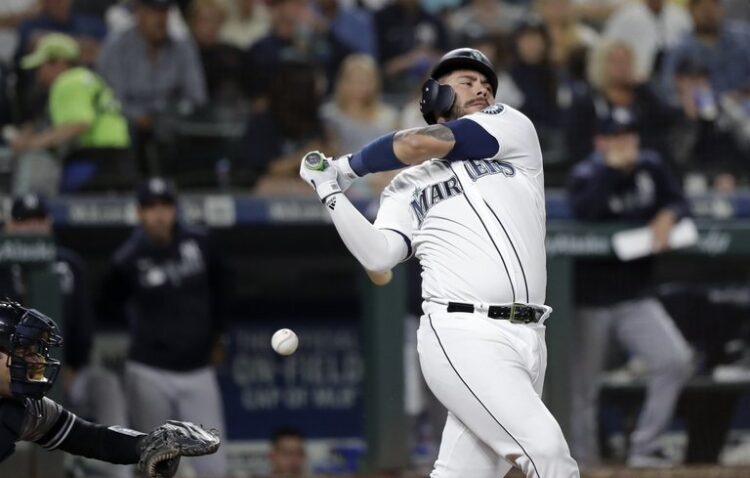2020 Fantasy Baseball: Fun with PECOTA–Catchers

One of the biggest thrills every year is getting the annual Baseball Propsectus book. They use a system called PECOTA which has its own brand of projections for the coming season. Is it more accurate than Steamer, ZIPS, Rotowire, or any other system? Perhaps it could be, but as a baseball junkie I just crave information. When you combine the sources together you often get a consensus on a player. Sometimes you don’t.
Since we already looked at potential catchers to target, we are going to do something a little different. We are going to compare catcher rankings according to PECOTA in comparison with their draft stock in Yahoo. Most of the time it is very similar, but occasionally you will get some wild variations. We will take a look at those and continue through the diamond at a leisurely pace. Before we get started, I think it is always instructive to look at positional averages based on our (now three) major sources. When you see how the PECOTA averages compare to Steamer and Rotowire it can give you a glimpse of how players must measure up in a relative way. Positional averages are based on the top 25 catchers on our board.
STEAMER: .246/16 HR/47 Runs/51 RBI/2 SB/33 BB
Rotowire: .252/17 HR/51 Runs/56 RBI/1 SB/36 BB
PECOTA: .240/18 HR/51 Runs/57 RBI/2 SB/36 BB
Why does this matter? Simply put, we know going in that Rotowire is bullish on batting average for catchers where PECOTA is rather bearish. All of the other numbers seem fairly close. PECOTA adds another number I like to use called Value of Replacement Player (VORP). It calculates the number of runs above a replacement level catcher that any of these players are offensively. No metric is perfect, but I like VORP because it combines quality and durability into one number. Obviously, you have to play a lot to build up a higher VORP.
So, we will identify three players who have a positive gap in VORP (higher ranking in VORP than where they were drafted) and three players with a negative gap (lower ranking in VORP than where they were drafted). We will include walks as a sixth category but we will give both five and six category draft rankings to include as many formats as possible.
Positive Gap Catchers
Omar Narvaez–Milwaukee Brewers
VORP: 28.5 (6th)
Yahoo Five: 17th
Yahoo Six: 13th
PECOTA: .269/17 HR/57 Runs/61 RBI/1 SB/49 BB
Should Narvaez be a fantasy starter? Based on these numbers he probably should be. In terms of positional averages, Narvaez is north in batting average, runs, RBI, and walks. Stolen bases barely count and he is only one home run away from the average. The issue with Narvaez will be playing time. He is not a well regarded pitch framer, so that might eat into his playing time this year. Still, if this guy is available in your league you should snatch him up as at least a quality backup for your regular fantasy catcher.
Tom Murphy–Seattle Mariners
VORP: 17.3 (9th)
Yahoo Five: 24th
Yahoo Six: 26th
PECOTA: .238/24 HR/55 Runs/67 RBI/3 SB/30 BB
These numbers are considerably different than what Rotowire and Steamer are putting out. Do the folks at BP know something those other guys don’t? That’s part of the fun of forecasting. I wouldn’t bet on these numbers, but you never know. People that win fantasy leagues are those that dominate the waiver wire and those that take chances on players early on. He is owned in only 18 percent of Yahoo leagues, so he could qualify on both fronts.
Mike Zunino–Tampa Bay Rays
VORP: 9.2 (20th)
Yahoo Five: 45th
Yahoo Six: 41st
PECOTA: .207/23 HR/52 Runs/63 RBI/1 SB/33 BB
You can see the numbers for yourselves. Let’s say he meets these numbers. Discounting stolen bases, he would meet the average in three of the other five categories. He’s in the neighborhood on walks. So, how much do you want to punish a guy for a low batting average? Players like Zunino are streaky. He could be a stash guy until he busts out into a hot streak. Mixing and matching guys as much as possible is one way to take a seemingly lackluster position group and get more out of it.
Negative Gap Catchers
Wilson Ramos–New York Mets
VORP: 14.4 (11th)
Yahoo Five: 7th
Yahoo Six: 7th
PECOTA: .263/15 HR/51 Runs/57 RBI/1 SB/33 BB
A four position swing doesn’t seem like much, but the seventh ranked catcher in VORP sits at 28.4. The drop off to number eight is significant. You should always pay attention to those gaps because you can exploit them on draft day. Why overpay for the eighth ranked catcher (Carson Kelly) when there are two others that are pretty darn close? Of course every draft is different and organic to itself. If VORP is too fancy for you just consider the fact that Ramos is below average in dingers, steals, and walks, and barely average in runs and RBI. So, you are buying on batting average. Chasing single categories can be dangerous.
Salvador Perez–Kansas City Royals
VORP: 14.0 (12th)
Yahoo Five: 9th
Yahoo Six: 10th
PECOTA: .245/25 HR/59 Runs/74 RBI/1 SB/20 BB
I’m down with OBP (yeah you know me). I’m down with OBP (yeah you know me). Fantasy baseball and real baseball are often two different animals. The ability to steal first base is the most important skill when it comes to sabermetric bent metrics like VORP. In a five category league that doesn’t matter. He is above average in everything but steals in those formats, so he might even be a bit underrated. In six category formats it could be much worse depending on whether it is walks or OBP, so pay attention to how your league scores.
Christian Vazquez–Boston Red Sox
VORP: 10.6 (18th)
Yahoo Five: 10th
Yahoo Six: 11th
PECOTA: .246/16 HR/56 Runs/62 RBI/6 SB/36 BB
Again, this is a fascinating gap that has a number of layers to it. VORP is calculated with ballpark effects in mind. Fenway is a hitter’s park, so the typical replacement level catcher will perform a little better there. PECOTA has him below average only in home runs and somewhere between average to good in every other category. By sheer definition that would peg his rankings as at least in the ballpark. He definitely should be rostered in every league, but it is fair to question whether he should be a fantasy regular.


